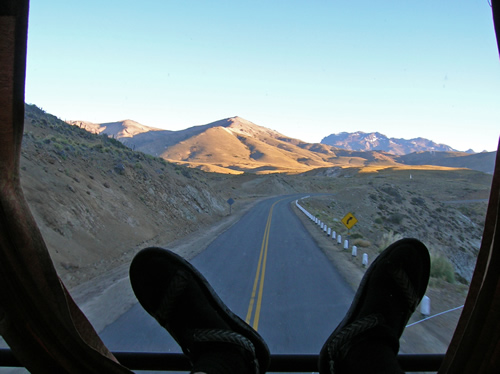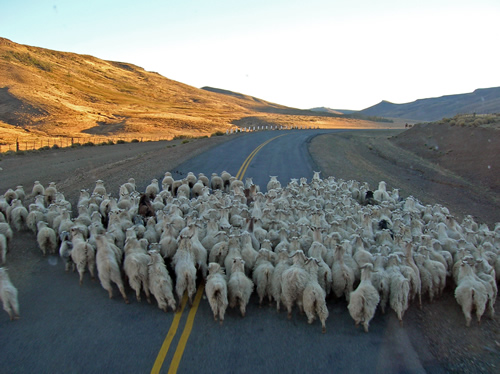How to Travel Overland in South America
Tips for Independent Travelers
By Volker Poelzl

|
Enjoying the view from a double-decker bus in Argentina.
© Volker Poelzl. All Rights Reserved.
|
I have always been fascinated by crossing South America by road. Long before my first visit to this vast continent, I enjoyed following the Pan-American highway with my finger on the map until I reached its end at the southern tip of Chile. I followed the course of the Transamazonian highway with equal interest as it dissected the Brazilian Amazon from east to west. However, during my first yearlong stay in South America, I discovered that road travel on this vast continent is more challenging than maps suggest. We have written this for those travelers in South America who plan to see the continent mainly through overland travel. We will build upon our experiences to help you plan an enjoyable and safe trip.
About the Roads
Road conditions vary drastically between countries and regions. In general, South America is connected by a sound system of highways, which, although often in bad repair, function as vital arteries for transporting goods and passengers. The locals are accustomed to the regional road conditions and regularly travel on roads that most travelers from North America and Europe would consider unsafe and dangerous. The more developed countries have a modern highway system that connects all major cities. Yet, divided highways are rare, and most major highways are just paved two-lane roads.
Expect road conditions to deteriorate in remote areas and developing countries or regions, even though your map may indicate an important highway. If you plan on long-distance road travel, the region's geography will tell you much about the type of road conditions to expect. The Andean mountains, the vast Amazon basin, and extensive flood plains in low-lying areas are formidable obstacles to road construction, and road travel can be a significant challenge in these parts of South America. Roads in the mountains are regularly severely damaged or destroyed by rocks and landslides. In the low-lying areas, roads are washed out and become impassable during the rainy season.
South America by Bus
Bus travel is the most common form of public transportation in South America, both for short — and long-distance travel. You can travel by bus, shared minivan, or truck wherever there is a road. Be prepared, however, as the quality of bus travel varies enormously depending on the route, region, and country you are traveling on.
In the more developed countries of South America, such as Argentina, Brazil, Chile, and Uruguay, bus travel can safely be called the best in all of the Americas. Air travel is still expensive for most South Americans, and most travelers take the bus, often on long-distance and overnight routes. Since competition is fierce between bus companies, the level of comfort and service is essential to attract customers. On popular routes between major cities, you often choose between several different comfort categories, from conventional to luxury class. You can travel in comfortable and quiet double-decker buses with reclining seats, clean bathrooms, meals, onboard movies, and direct service.
In remote areas, on the other hand, you might find yourself traveling on a dirt road in the back of a large pickup truck, sitting on a wooden bench crowded with local passengers and surrounded by barrels of smelly diesel fuel. The unpredictability of road travel in South America makes it both an adventure and a challenge. Some years ago, I could not book a flight from the Bolivian Amazon to the capital, La Paz. I went to the local bus company, and they showed me an attractive album of brightly painted and beautiful buses that would make the trip to La Paz, some 10,000 feet up the Andes, in about 48 hours. Pleased with the pictures of the new buses I was shown, my girlfriend and I bought the last two available seats. We boarded the neatly painted bus and quickly realized the interior did not reflect its external appearance. Windows were cracked or did not open; there was no air conditioning, and the seats were worn out with the backrests immovable or often entirely broken. However, we had already purchased the tickets. After watching our backpacks being strapped onto the roof rack and covered with a large tarp, we embarked on our journey. And a journey it was, or rather more like an Odyssey. The bus experienced numerous breakdowns and delays; the trip took four days instead of two. The road up the Andes to La Paz often narrowed to a one-lane dirt road, and the many hairpin turns made it seemingly impossible to spot oncoming traffic. But we arrived.

|
|
When traveling across South America, you will often find sheep using the road as well. © Volker Poelzl. All Rights Reserved.
|
If you travel by bus, bring a good road map. It is always a good idea to know where you are. Assume you have a smartphone or laptop available and charged. In that case, you can use the technology and tools available, assuming you have reception and connectivity. But be prepared to make your trip as comfortable as possible. Bring a small pillow or sweater to use as a pillow. If you are concerned about noise on an overnight bus ride, take some snacks, reading materials, a music player, and earplugs. Get off the bus at every stop and stretch your legs.
Organized Bus Tours
Although firmly committed to independent travel, there are times when I have booked day trips with travel agencies to see local attractions and visit places that would otherwise be inaccessible. Many attractions in South America are frequented by bus tours, which often visit several destinations in one day, which is frequently difficult by public transportation. Many tours and excursions are hawked on the streets of tourist destinations, and you should compare prices and itineraries before signing up for a tour. You can also find websites selling bus tour packages and book in advance.
South America by Train
Railroads on this vast continent are mostly a relic of a past era of glory. Many of them were built in the late 19th century to demonstrate a country's modernity and progress, but little remains of these railroads today. Except for commuter trains, few railroads in South America today are a vital part of public transportation. Train travel in South America is limited chiefly to commuter trains in metropolitan areas. Overland routes are often old-fashioned and very slow, with an aging running stock of trains and poorly maintained rails.
Paul Theroux's memorable travel tale, "The Old Patagonia Express," described traveling from Boston to the tip of South America by train. There was far more hardship, unexpected adventures, and delays than most travelers desired. Nevertheless, there are currently some notable exceptions. Peru, Chile, and Argentina maintain several long-distance railways, some very scenic. Among the most memorable train rides include the trip up the Andes from Lima to Cuzco. The journey from Cuzco to Machu Picchu is something everyone should try once. But for the most part, railroads in South America today are dedicated to transporting ore, timber, and grain to the nearest port and do not offer passenger service. Railway travel in South America is mostly for the weekend railroad aficionado. Old steam engines often operate the few short historic routes in South America.
South America by Rental Car
Road conditions are often unpredictable on long overland routes in much of South America, and urban traffic is so chaotic and congested that renting a car is not always a safe and enjoyable means of getting around. Avoid driving at night under any circumstances since you cannot detect dangers and obstacles as clearly as during the day. Some driving hazards are human-made. Many Brazilian towns have put up speed bumps on main roads, most unmarked and invisible at night, to slow down reckless drivers. They cannot only destroy the suspension of your car but can also cause serious accidents.
On the other hand, regional car rental for a few days can be an enjoyable alternative to public transportation. You have much more flexibility, and since you will only be traveling short distances, you will not be exhausted and worn out from the challenges of the road.
Hitchhiking in South America
(For the Adventurous)
I have hitchhiked in 20 countries worldwide, and except for Europe, South America is the continent where I have traveled the most by thumbing rides. As a word of warning, hitchhiking can be dangerous no matter where you are, and I do not recommend it as a primary mode of travel. However, those travelers who already have experience hitchhiking might like to learn more about what to expect when doing so in South America.
First, it is not worthwhile in South America to hitchhike long distances to save money. Bus travel is regular and cheap enough to get you where you need to go. However, as a budget and independent traveler, I have found hitchhiking very useful for short routes that lack public transportation and where the only other option would be a costly taxi ride. Remember that most traffic, except for trucks, is local, and you should be ready to travel in just about any vehicle with four wheels and an engine. My first hitchhiking adventure in South America was a rather unglamorous ride. A friend of mine and I had decided to go hiking in Brazil's Itatiaia National Park, between Rio de Janeiro and São Paulo. But once we got to the nearest town, we discovered no transportation to take us to the trails inside the park. Our only option was to hitchhike; that is how we took a 6-mile ride in the back of a garbage truck. Since then, I have hitched rides in the backs of timber trucks, cattle trucks, pickup trucks, and old sedans crowded with family members on a weekend excursion. Keep in mind that hitchhiking is much easier if you speak a few words of the local language. Knowing the local language prevents misunderstandings about your ride's destination. You will also be able to strike up conversations with the driver — which often prove to be as exciting and insightful as any part of your travels.
Volker Poelzl is a Living Abroad Contributing Editor for TransitionsAbroad.com. He has extensively traveled in South America, both by air and on the ground.
|
